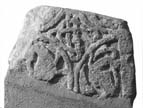Select a site alphabetically from the choices shown in the box below. Alternatively, browse sculptural examples using the Forward/Back buttons.
Chapters for this volume, along with copies of original in-text images, are available here.
Object type: Two pieces from a cross-shaft
Measurements:
1a: H. 33.7 cm (13.2 in); W. 37.4 cm (14.7 in); D. 28 > 24.6 cm (11 > 9.7 in)
1b: H. 32.8 cm (12.9 in); W. 42.2 > 40 cm (16.6 in > 15.7 in); D. 32.4 > 28 cm (12.7 > 11 in)
Stone type: Yellowish grey grain supported shelly oolite with hollow ooliths ranging between 0.5 and 0.6 mm in size. Some shell debris up to 6 mm in size consisting of bivalve and brachiopod fragments. Cleeve Cloud Member, Birdlip Limestone Formation, Inferior Oolite Group, Middle Jurassic.
Plate numbers in printed volume: Ills. 265-73; Figs. 17, 24A-D, 27A-B
Corpus volume reference: Vol 10 p. 207-8
(There may be more views or larger images available for this item. Click on the thumbnail image to view.)
Two non-adjacent pieces of a tapering cross-shaft.
A (broad): 1a. On the upper stone the central rib splits to form a concave-sided diamond, the centre of which is filled with an interlace formed from three separate loops. Below the diamond two lively little winged creatures bite the stems of the vine leaves surrounding them.
1b. On the lower stone two addorsed birds sit on knots of median-incised interlace that have developed from their own tails, either side of a double central rib that swells into a ridged node near the top of the stone. The surviving edge moulding is plain with a narrow band running up the inside. This band should probably be seen as part of the decorative scheme. A curving, downward-pointing leaf touches the breast of the left-hand bird.
B (narrow): Both 1a and 1b carry a median-incised, inhabited vine-scroll. On 1a a club-tailed, winged biped is locked in a simple volute. On 1b a beautiful little bird perches on a tendril and a berry bunch, and pecks at one of the elongated berry bunches that fill the rest of the volute.
C (broad): Both 1a and 1b carry a loose, median-incised interlace. On the upper stone there is what is probably the wing of a large bird caught in the interlace.
D (narrow): The carved face survives only on 1b and consists of a median-incised vine-scroll with a whorl of leaves spinning round inside the volute, around an interlace pattern that seems to consist of four superimposed, crook-shaped stems.
The vine-scroll on face B of Gloucester St Oswald 1 (Ills. 266, 269) is similar to many of the eighth-century crosses from Northumbria. The creatures on face A and face B are finely carved and lively, and the closest parallels are also found on early to mid eighth-century crosses and slabs from Northumbria. The bird in the lower volute of face B (Ills. 269, 272) is the thrush type found at Bewcastle, Jarrow, Jedburgh, Otley and Ruthwell. Winged bipeds, like the creature in the top volute on face B (Ills. 266, 273), occur at Jedburgh and Ruthwell. There is an exact parallel from Jedburgh for the grape clusters with elongated terminal tips that are found in the lower volute of face B (Ill. 272). The pairing of birds and beasts either side of a central rib or stem with ridged nodes, as on face A at Gloucester (Ills. 263, 268), is rather more uncommon but can be paralleled at Jedburgh and Jarrow. In these cases, however, the creatures stand in simple volutes which are missing from the more constrained space available at Gloucester. Rosemary Cramp (Cramp 1977, 225) has suggested a date in the late eighth century for this cross.
The St Oswald's crosses (Gloucester St Oswald 1 to 4)
There are four cross-shafts from St Oswald's, and it is suggested that the crosses can be viewed as a typological sequence, with this cross at the beginning and Gloucester St Oswald 4 at the end. The date proposed for no. 4 means that it stood for little more than sixty or seventy years before it was broken up and incorporated in the footings of the church. It is likely that all four crosses stood together, and certainly no. 2 seems to have used no. 1 as a model. St Oswald's was not itself founded until the late ninth century (see Gloucester St Oswald 5, p. 269), and these four crosses are thus earlier than the recorded establishment of the minster. That they came from the actual site of the later church cannot be proven, but this seems probable; there is one Anglo-Saxon burial predating the church which could indicate a ninth-century cemetery, while one late source suggests an earlier foundation at the site, though the details are implausible (Hare 1999, 34). At the least, this group of high status monuments is an indication of the importance of Gloucester's riverside area during this period (for further discussion of the context of these crosses, see Heighway and Bryant 1999, 9–10). Although many changes of style can be traced through the group of crosses, there are also consistencies, with the dominant features being Hiberno-Saxon in character, displaying vine-scrolls and tree-scrolls, dense patterning of surfaces, and birds and animals in profusion. Early contacts with Northumbria may offer a major potential source for these Hiberno-Saxon traditions (Sims-Williams 1990, 101–5), and the Bristol Channel gave direct contact with Ireland. However, the exuberance of this style in the western Midlands during the later eighth and ninth centuries may also reflect the survival of native British traditions or influences, as has been suggested for the similar Wessex carvings (Cramp 2006, 47).



